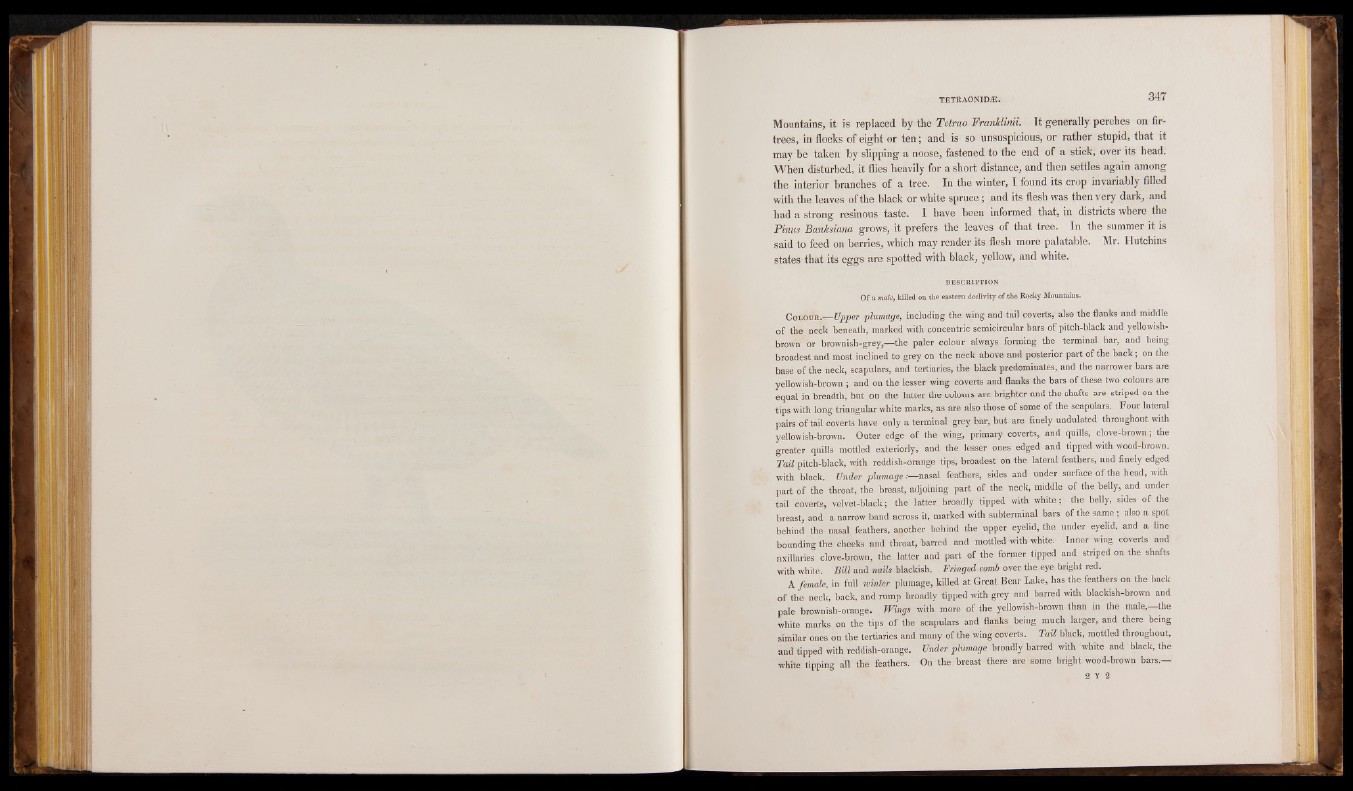
Mountains, it is replaced by the Tetrao Franklinii. It generally perches on fir-
trees, in flocks of eight or ten; and is so unsuspicious, or rather stupid, that it
may be taken by slipping a noose, fastened to the end of a stick, over its head.
When disturbed, it flies heavily for a short distance, and then settles again among
the interior branches of a tree. In the winter, I found its crop invariably filled
with the leaves of the black or white spruce ; and its flesh was then very dark, and
had a strong resinous taste. I have been informed that, in districts where the
Pirns Banhiana grows, it prefers the leaves of that tree. In the summer it is
said to feed on berries, which may render its flesh more palatable. Mr. Hutchins
states that its eggs are spotted with black, yellow, and white.
DESCRIPTION
Of a male, killed on the eastern declivity of the Rocky Mountains.
C olo u r .—Upper plumage, including the wing and tail covertSj also the flanks and middle
of the neck beneath, marked with concentric semicircular bars of pitch-black and yellowish-
brown or brownish-grey,—the paler colour always forming the terminal bar, and being
broadest and most inclined to grey on the neck above and posterior part of the back; on the
base of the neck,_scapulars, and tertiaries, the black predominates, and the narrower bars are
yellowish-brown ; and on the lesser wing coverts and flanks the bars of these two colours are
equal in breadth, but on thé latter the colours are brighter and the shafts are striped on the
tips with long triangular white marks, as are also those of some of the scapulars. Four lateral
pairs of tail coverts have only a terminal grey bar, but are finely undulated throughout with
yellowish-brown. Outer edge of the wing, primary coverts, and quills, clove-brown; the
greater quills mottled exteriorly, and the lesser ones edged and tipped with wood-brown.
Tail pitch-black, with reddish-orange tips, broadest on the lateral feathers, and finely edged
with black. Under plumage:—nasal feathers, sides and under surface of the head, with
part of the throat, the breast, adjoining part of the neck, middle of the belly, and under
tail coverts, velvet-black; the latter broadly tipped with whiter the belly, sides of the
breast, and a narrow band across it, marked with subterminal bars of the same ; also a spot
behind the nasal feathers, another behind the upper eyelid, the under eyelid, and a line
bounding the cheeks and throat, barred and mottled with-white, Inner wing coverts and
axillaries clove-brown, the. latter and part of the former tipped and .striped on the shafts
with white. Bill and nails blackish. Fringed comb over the eye hrjght red.
A female, in full winter plumage, killed at Great Bear Lake, has the feathers on the back
of the neck, back, and rump broadly tipped with grey and barred with blackish-brown and
pale brownish-orange. Wings with more of the yellowish-brown than in the male, the
white marks on the tips of the scapulars and flanks being much larger, and there being
.imil.r ones on the tertiaries and many of the wing coverts. Tail black, mottled throughput,
and tipped with reddish-orange. Under plumage broadly barred with white and black, the
white tipping all the feathers. On the: breast there are some bright wood-brown bars.—